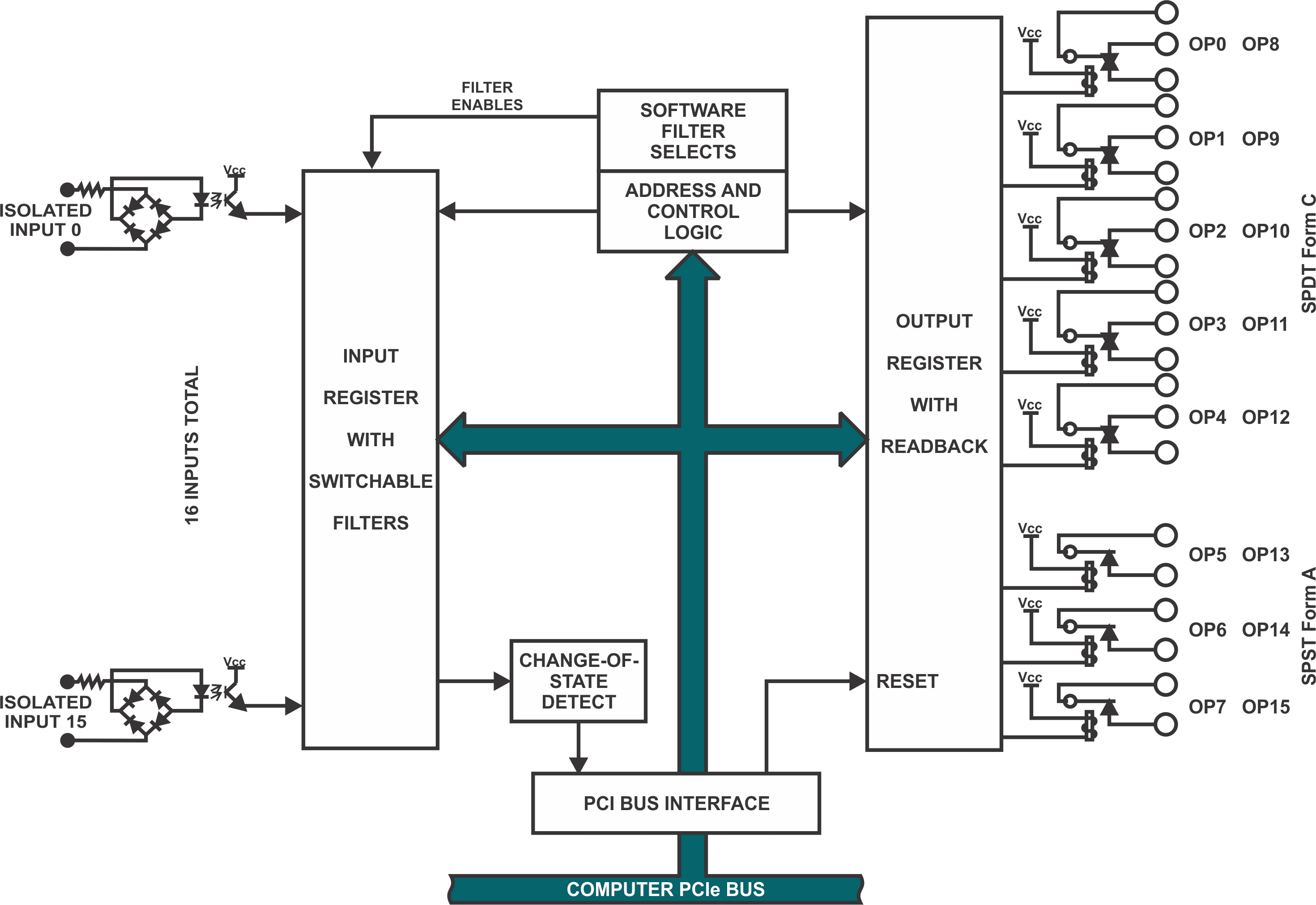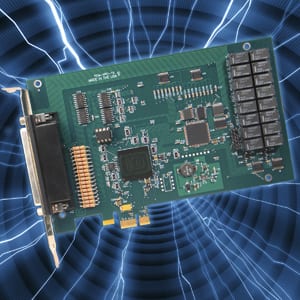PCIe-IIRO-16 Family
PCIe Isolated Input Relay Card with COS IRQ and advanced Digital Integration Features
Features
- 16 optically isolated, non-polarized digital inputs
- Switchable filters on inputs for electrically noisy environments
- Optically isolated channel to channel and channel to ground
- Can detect input state change and assert interrupt
- Models now include Digital Integration Features
- 8 bits with Edge-selectable Event Counting, Pulse Width and PWM measurement, and per-bit Edge-selectable CoS IRQs
- 8 bits with Pulse Train (“generate n pulses”) and PWM generation
- 16 electro-mechanical relay outputs
- DB78 Female I/O Connector on Card Mounting Bracket
- Automatically detected under Windows
- Designed, made, supported, and manufactured in the USA
FACTORY OPTIONS
- Extended temperature operation (-40° to +85°C)
- RoHS compliant version
- Support for Wind River VxWorks (call for ordering information)
$419.00
In StockDescription
This product is a x1 lane PCIe isolated digital input and relay output board with Change of State (COS) detection capabilities.
The isolated inputs can be driven by either AC or DC and are not polarity sensitive. Input signals are rectified by a diode bridge and applied to the inputs of opto-isolators. A 1.8k ohm resistor in series provides current limiting. Standard 12/24 AC control transmitter outputs can be accepted as well as DC voltages. The input voltage range is 3V to 31VDC (or 40-10kHz RMS). To extend the input voltage range, you may connect external resistors in series.
The electro-mechanical relay outputs of the PCIe-IIRO-16 are comprised of ten form C SPDT outputs and six form A SPST (normally-open) type. The relays are all de-energized at power-on. Data to the relays is latched.
The card is 6.6 inches in length and 4.2 inches seated height. I/O wiring connections for this board are via a female 78-pin D-sub connector. A molded round-wire “Y” cable is typically used to connect this card to termination panels with two 37-pin D-sub connectors.
Digital ∫ Features
Models include new Digital Integration Features on 8 bits of input and 8 bits of output.
- Inputs: Enhanced Change-of-State IRQs can be enabled on a bit-by-bit basis, with a selectable (rising/falling) edge. Separately enabled per-bit edges are counted with an optional overflow IRQ. Low-side and high-side pulse widths are measured with a resolution as fine as 8ns. These measurements automatically provide both frequency and duty cycle measurements for waveforms up to 65.5 MHz.
- Outputs: Individual rising-or-falling pulses can be generated, individually or simultaneously on up to 8 output bits, with durations controllable with 8ns resolution. Sequential pulses or continuous frequencies (with programmable duty-cycle) can also be output.
- EZUpdate: FPGA supports EZUpdate allowing new FPGA code to be written via software across the PCI Express bus, allowing field upgrade with new features.
For details regarding Digital Integration Feautres please refer to the Digital Integration Features Reference.
SOFTWARE
The card is supported for use in most operating systems and includes a free DOS, Linux, and Windows XP -> 10, both 32 & 64 bit compatible software package. This package contains sample programs and source code in Visual Basic, Delphi, and Visual C++ for Windows. Also provided is a graphical setup program in Windows. Linux support includes installation files and basic samples for programming from user level via an open source kernel driver. Third party support includes a Windows standard DLL interface usable from the most popular application programs. Embedded OS support includes Windows Xpe, WES7, vxWorks, etc.
Modified-COTS (MCOTS) Customization
ACCES can tailor any standard product to your precise requirements — electrical, mechanical, firmware, environmental, or connector-level. Common MCOTS options include alternate I/O ranges, isolation enhancements, firmware changes, private labeling, conformal coating, extended temperature operation, ruggedized enclosures, and military-grade components. If this product is close but not a perfect fit, our engineering team can deliver a rapid-turn MCOTS variant with minimal NRE and dependable, Made-in-USA quality.
Downloads
Data Sheets
Manuals
- Digital Integration Features Register Reference
- PCIe-IIRO-16 Manual
- AIOWDM Software Reference Manual (.html)
Software
- PCIe-IIRO-16 Software Package ( -- Last Uploaded 2025-05-07)
Drivers and Downloads
Full list of available Downloads: Software Packages, Drivers, Manuals, and other documents
Information about our Free Software packages:
ACCES is proud to provide a full suite of software support with every Data Acquisition product. We are committed to supporting the most popular operating systems and platforms for our customers. Currently we are actively supporting 7 -> 11, both 32 & 64 bit, including “Server 2008,” “Embedded,” and “Compact” flavors for all plug-and-play products including PCI, PCI Express, USB, and more. Many products continue to ship with support for additional operating systems such as DOS, Windows 95, 98, Me, NT4, 2000, and XP.
Samples
Among the software we deliver with our products are sample programs in a wide variety of programming languages. These samples are used to demonstrate the software interfaces to our products — and many can be used as-is in your production environments, or to test functionality of the devices out-of-the-box. We’re currently actively supporting sample programs in Microsoft Visual C#, and Delphi, with many devices including samples in Visual Basic (5 and .NET), Visual C/C++, and Borland C/C++ 3.1 for DOS. Additionally we provide National Instruments LabVIEW compatible DLLs and many demonstration VIs for our devices.
Drivers
Drivers for various operating systems are also provided, including active support for Windows 7 -> 11 — all in both 32-bit and 64-bit flavors, and including consumer, server, and embedded varieties — as well as the 2.6 and newer Linux kernels and recent OSX / macOS versions. Many products continue to ship with driver support for Windows 95, 98, Me, NT4, Windows 2000, XP, and more, but support for these operating systems is considered deprecated.
Setup Programs and Utilities
Our Data Acquisition devices also include a graphical setup utility that walks you through the process of configuring any option jumpers or switches on the device, as well as explaining a little about the various connectors present.
Many devices also include utility programs – little tools to make your use of the device easier, such as EWriter, a program that allows you to read and write data in the user-accessible EEPROM locations on all our USB data acquisition products; or WinRISC, a “Really Incredibly Simple Communications” terminal program that lets you get started instantly with serial devices.
“Register Level” Documentation
Besides all this software in all these languages and operating systems ACCES has a policy of open and transparent development: none of our lowest-level “register” interfaces are hidden from you — we document every register in every bus card, every command in every serial board, and every usb control transfer in every USB Data Acquisition board. These lowest-level interfaces allow you to develop for our products in ANY operating system or language, regardless of our actively supporting it or having a driver for it. We have customers actively developing in ADA, Android, Python, Java, MATLAB, Solaris, and more, just by referring to our complete low-level interface documentation! And we provide the full source code to all of our drivers, regardless of operating system, to give you an even bigger head start in your own development tasks.
No Fees or Royalties
All of this software is provided at no additional charge, and is licensed under any of a variety of flexible — and royalty free — options. Check out our software license explanation if you’d like more information.
Custom Software
ACCES also offers Custom Software Services for our products. Our prices are unbelievably low, often as inexpensive as free! If you need something tweaked to support your needs, or an entire enterprise application developed from scratch, it is definitely worth your time to inquire with us, first.
Further information about available ACCES Software:
Redistributing Windows Drivers
A list of ACCES drivers and the files that compose them under different versions of Windows, so you can easily redistribute ACCES cards and drivers.
aioWDM.VxWorks
ACCES has successfully partnered with Wind River to bring our entire line of PCI and PCI Express DAQ cards to VxWorks 7!
VxWorks 7 VxBus Gen 2 drivers, with easy-to-use API-libraries, are available for this product, including full source and sample code.
Designed to be compatible with our AIOWDM.dll Windows driver & API, this kernel module adds zero% CPU-cycle overhead to your VxWorks runtimes while allowing the lowest-latency hardware register access possible.
You can find more information about our VxWorks libraries and services on our Wind River Silver Partner page.

Digital Inputs
- Number of inputs: 16
- Type:Non-polarized, optically isolated from each other and from the computer. (not TTL/CMOS compatible)
- Voltage Range: 3 to 31V DC or AC (40 to 10 kHz)
- Isolation: 500V*(see manual) channel to channel and channel to ground
- Input Resistance: 1.8k ohms in series with two diodes and a photo-coupler LED
- Response Time: 10 mSec w/filter, 20 uSec w/o filter
Relay Outputs
- Number of outputs: 16
- Max Switching Current: 1 A
- Contact Rating: 2 A carry current, bifurcated, gold clad, Au-alloy
- Contact Arrangement: Channels 0-4 and 8-12 are SPDT Form C; channels 5-7 and 13-15 are SPST Form A.
- Contact Rating: Initial 100 mΩ maximum
- Contact Life: mech’l: 5 million operations minimum; elect’l: 5 million operations minimum at full load
- Operating Time: 5 ms maximum
- Release Time: 5 ms maximum
- Regulatory Approvals: UL and CSA
Interrupts
- Interrupts enabled by software, generated when digital inputs change state
Connector
- Back Panel DB78 Female
Power Required
- +5VDC @ 0.750 A (all relays ON)
Environmental
- Temperature: Operating 0 to +70°C
- Storage: -40 to +85°C
- Humidity: 0 to 90 percent (non-condensing)
- Weight: Approx. 8 oz. (227 grams)
- Size: PCIe-IIRO-16 is 6.15″ (156 mm) long
Regulatory Compliance
This product is in full compliance with CE requirements.
OEM and volume pricing available, please call us.
| Model | Description | Price (USD) | |
|---|---|---|---|
| PCIe-IIRO-16 | PCI Express Isolated Relay I/O Card | $419.00 |
| Accessories | ||
|---|---|---|
| CAB78-37/2 | $80 | 6′ round-wire “Y” cable, DB78 connector terminates in two DB37 female connectors |
| STB-37/2 Kit | $159 | Screw terminal kit includes two STB-37’s, one CAB78-37/2, and a one foot SNAP-TRACK |
| STB-37/2 Kit-CL | $178 | STB-37/2 Kit with four DIN clips for mounting theSTB-37/ SNAP-TRACK assembly to a DIN-Rail |
| STB-37 | $39 | DIN-Rail mountable screw terminal board with DB37 male connector |
| STA-37 | $79 | Wireable screw terminal board with DB37 male and female connectors |
| Model Options (call for pricing) | ||
| -RoHS | Call | RoHS compliant version |
| -T | Call | Extended temperature operation (-40° to +85°C) |


